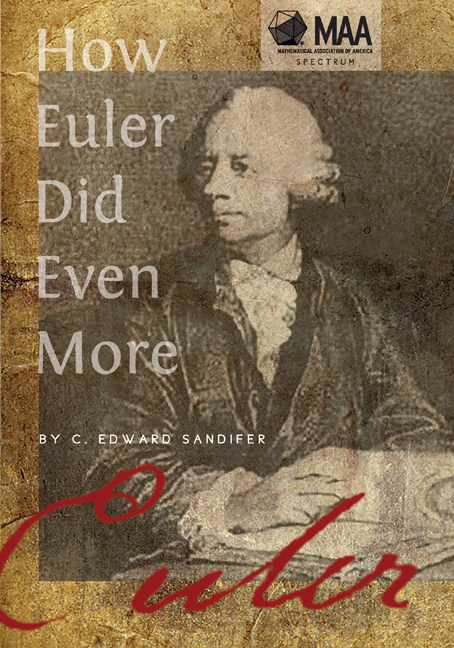Book contents
- Frontmatter
- Contents
- Preface
- Part I Geometry
- Part II Number Theory
- Part III Combinatorics
- Part IV Analysis
- Part V Applied Mathematics
- Part VI Euleriana
- 31 Euler and the Hollow Earth: Fact or Fiction? (April 2007)
- 32 Fallible Euler (February 2008)
- 33 Euler and the Pirates (April 2009)
- 34 Euler as a Teacher – Part 1 (January 2010)
- 35 Euler as a Teacher – Part 2 (February 2010)
- About the Author
32 - Fallible Euler (February 2008)
from Part VI - Euleriana
- Frontmatter
- Contents
- Preface
- Part I Geometry
- Part II Number Theory
- Part III Combinatorics
- Part IV Analysis
- Part V Applied Mathematics
- Part VI Euleriana
- 31 Euler and the Hollow Earth: Fact or Fiction? (April 2007)
- 32 Fallible Euler (February 2008)
- 33 Euler and the Pirates (April 2009)
- 34 Euler as a Teacher – Part 1 (January 2010)
- 35 Euler as a Teacher – Part 2 (February 2010)
- About the Author
Summary
By now, regular readers of this column might have come to believe that, except for occasional computational errors beyond the 15th decimal place, and except for a regular and flagrant disregard of the issues of convergence when dealing with series, Euler was always right about everything. Now that 2007, the so-called “Euler year” is over and the celebrations of the 300th anniversary of his birth are winding down, perhaps we will be forgiven if we admit an uncomfortable fact: Euler was sometimes wrong. We are devoting this month's column to a few of the things Euler was wrong about.
Lunar atmosphere
Euler thought that the moon had an atmosphere. In [E142], Sur l'atmosphere de la Lune prouvée par la dernier eclipse annulaire du Soliel, (On the atmosphere of the Moon, proved by the recent annular eclipse of the Sun), Euler describes the observations made in Berlin of the eclipse of July 25, 1748. Euler says that he himself took part in the observations, and this would be a rare example of Euler taking his own data. Other sources indicate that sisters Christine and Margarethe Kirsch assisted him. Christine is known for carefully keeping a diary of the weather for many years.
Euler and his assistants set up a telescope in a darkened room, making what we call a camera oscura. This allowed the image of the sun to be projected onto a white screen. The details of the eclipse had been calculated in advance by Johann Kies, and they had used Kies's calculations to draw a circle on the screen in the position where the eclipse was predicted. If the calculations were accurate, the image of the eclipse at its maximum would exactly coincide with the circle at exactly the time predicted.
They didn't. Though the time and position of the images were as predicted, the sizes were observed to differ in two significant ways.
First in order of occurrence, but probably second in importance, the crescent of the sun as the eclipse approached its maximum (an annular eclipse doesn't reach totality) did not behave as expected.
- Type
- Chapter
- Information
- How Euler Did Even More , pp. 215 - 222Publisher: Mathematical Association of AmericaPrint publication year: 2014



